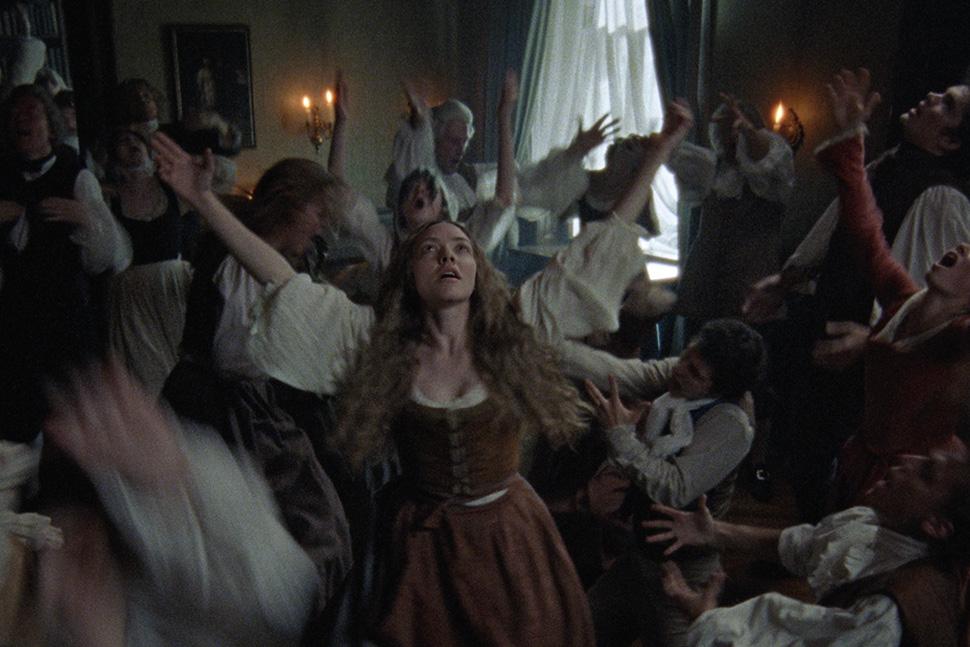An audacious avant-garde musical biopic of a messianic 18th century female religious leader, The Testament of Ann Lee is the most boldly original statement yet from Norwegian indie writer-director Mona Fastvold.
Featuring an all-singing, all-dancing ensemble cast headed by Amanda Seyfried, this emphatically artisan project is Fastvold’s poetic love letter to the founder of the Shaker movement, a now near-extinct Christian sect who nevertheless left behind a legacy of proto-feminist progressive values, psalm-like devotional songs and finely crafted DIY design.
Fastvold typically works in close collaboration with her American film-maker husband Brady Corbet, who shares script and second unit directing credits here. Indeed, she shot The Testament of Ann Lee soon after Corbet competed his period epic The Brutalist (2024), using some of the same cast, crew and Hungarian locations. Corbet’s operatic architectural saga world premiered in Venice a year ago, earning rapturous notices that helped propel it to multiple Oscar-winning critical and commercial success. Twelve months later, Fastvold is back on the Lido with her own project, slightly less grandiose but similarly inventive in form and flavour.
Speculative and highly stylised, but firmly rooted in real people and events, The Testament of Ann Lee is the kind of defiantly off-beat auteur work that seems sure to divide critics – indeed, there were walk-outs and baffled reactions at the Venice press screening. The long runtime sags a little in places, particularity during the latter half, while some of the non-British cast members struggle with their specifically regional English accents. Even so, this is strong-voiced, admirably ambitious film-making that rewards patient viewers with fiercely committed performances, great visual finesse and superbly staged musical numbers.
Artfully framed as a series of literary chapters, with sporadic voice-over narration by one of Lee’s disciples (Thomasina McKenzie). The Testament of Ann Lee opens with the birth of the Shaker religious movement in the northern English industrial city of Manchester in the mid 18th century. More formally known as The United Society of Believers in Christ’s Second Appearing, this millenarian Christian sect was a radical breakaway offshoot from the Quakers, with Lee as its founder and charismatic leader.
The group soon earns its nickname the “Shaking Quakers” because of their ecstatic convulsions during worship, which Lee believes is a way of cleansing away sin. Fastvold and her team make these orgiastic rituals a central driving force of the drama with a series of brilliantly choreographed, chest-thumping song-and-dance number that power the plot forward. Credit is due here to choreographer Celia Rowlson-Hall, who previously worked on Corbet’s unorthodox pop-diva drama Vox Lux (2018).
The Shakers share a progressive commitment to pacifism, gender equality and opposition to slavery with the Quakers. But Lee take a much harder line against “lustful gratification of the flesh”, preaching that celibacy is the only way to earn divine grace. She has four children, but all die very young, a wounding personal loss which leads her to conclude God is punishing her for having sex with her husband Abraham (a colourless Christopher Abbott). Fastvold shoots several of these childbirth scenes as tragic horror tableaux, but she also shows Lee’s sex life with Abraham as a joyless obligation with an intriguing BDSM dimension. Before long, she is relaying messages directly from the Big Guy upstairs that “fornication” is the root of all evil,
Fleeing petty bureaucratic persecution in Britain, Lee and her preacher brother William (a brooding Lewis Pullman) lead a small band of followers across the Atlantic to the United States, setting up their first commune-style base in upstate New York. Despite defections by sexually frustrated members, including Abraham, plus hostility from the authorities, wary of the group’s pacifist neutrality in America’s Revolutionary War, Lee presses on with evangelical zeal, declaring herself the second coming of Jesus in female form. Along the way she faces jail, denunciation as a witch, and brutal misogynistic violence. Yet the Shakers endure, gradually converting thousands of new followers and establishing multiple communities.
Music is the engine of The Testament of Anne Lee, ever present and deeply woven into the film’s fabric. Regular Fastvold/Corbet composer Daniel Blumberg’s contemporary classical score is a densely layered electro-orchestral tapestry of percussive thumps, nerve-jangling strings and airy woodwind while the songs themselves set the lyrics from genuine antique Shaker spirituals to Blumberg’s avant-folk arrangements. Most are performed to camera by the cast in solo or choral mode, but with guest vocals in the mix from left-field luminaries including Scottish free jazz singer Maggie Nicols and Alan Sparhawk of US indie-rock trio Low. Tastes will vary but these are exquisitely crafted songs of faith and devotion, far removed from standard film musical fare
A kinetic whirlwind on screen, Seyfried shines as both lead singer and dancer on several numbers. She has half-jokingly called her vocal approach here “anti-singing” because it edges into more experimental, highly physical performance art at times. But she can deliver more traditional showtune-style numbers with conviction too, as she proved on Les Miserables (2012) and the Mamma Mia! films. She also pulls off a rare feat for an American by mastering Lee’s Manchester accent to a high degree, a skill apparently honed by watching online clips of British actress Maxine Peake, a native of nearby Bolton.
The Testament of Ann Lee could have been played as a tragic rise-and-fall melodrama, a cautionary study of messianic egotism, or even an arch musical parody of fringe religion in the vein of The Book of Mormon. But Fastvold delivers her unorthodox passion play with an admirably straight face, celebrating Lee’s legacy as an empowering, trailblazing female leader without sanitising her into a saint. Though not religious herself, the low-budget indie director has claimed she identifies closely with Lee’s stubborn self-belief, creating an entire queendom in the face of hardship and hostility.
The final credits are peppered with striking statistics about the Shakers, who have declined from an 18th century peak population of 6000 to just two today. It seems enforced chastity was not such a smart policy in the long run. The label lives on mainly as a byword for functionally beautiful kitchen and furniture design, which Fastvold dutifully incorporates into the film’s rich visual tableaux. Some scenes were shot at a real Shaker community, now preserved as a heritage tourist site.
Director: Mona Fastvold
Screenplay: Mona Fastvold, Brady Corbet
Cast:Amanda Seyfried, Thomasin McKenzie, Lewis Pullman, Stacy Martin, Tim Blake Nelson, Christopher Abbott, Matthew Beard, Scott Handy, Jamie Bogyo, Viola Prettejohn, David Cale
Cinematography: William Rexer
Editing: Sofia Subercaseaux
Production designer: Samuel Bader
Costume designer: Ma?gorzata Karpiuk
Music: Daniel Blumberg
Choreography: Celia Rowlson-Hall
Producers: Andrew Morrison, Joshua Horsfield, Viktória Petrányi
Production companies: Kaplan Morrison (US), Intake Films (UK), Proton Cinema (Hungary)
World sales: Charades
Venue: Venice Film Festival (Competition)
In English
130 minutes





